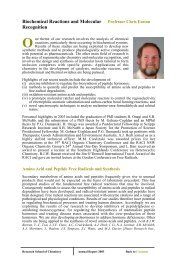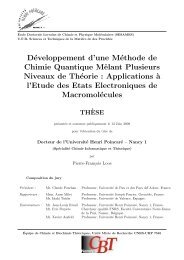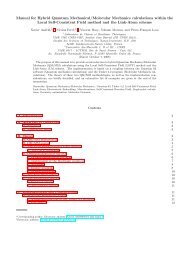View 2005 Report - RSC - Australian National University
View 2005 Report - RSC - Australian National University
View 2005 Report - RSC - Australian National University
You also want an ePaper? Increase the reach of your titles
YUMPU automatically turns print PDFs into web optimized ePapers that Google loves.
INORGANIC CHEMISTRY<br />
CaTiO 3<br />
, is a major component of Synroc, a synthetic rock form designed for the immobilisation of radioactive waste. Our<br />
interest in the Ca 1-x<br />
Sr x<br />
TiO 3<br />
, system derives from the fact that the CaTiO 3<br />
acts as a host for fission product Sr. It is therefore<br />
of some importance to precisely characterise the polymorphic and phase transition behaviour of this archetypal perovskite<br />
system. We are concentrating on regions of the phase diagram where significant disagreements currently exist in the<br />
literature. Attention is currently focussed on the x = 0.70 composition where diffraction studies have shown that the room<br />
temperature space group symmetry of Ca 0.3<br />
Sr 0.7<br />
TiO 3<br />
is I4/mcm rather than Imma as recently claimed. Work is also currently<br />
underway on the x ~ 0.63 composition where a novel anti-ferroelectric polymorphic form is being carefully investigated.<br />
(With C J Howard [ANSTO], B J Kennedy [U Sydney], M Carpenter [U Cambridge, UK])<br />
Structurally Frustrated Relaxor Ferroelectric Behaviour in CaCu 3<br />
Ti 4<br />
O 12<br />
Ever since CaCu 3<br />
Ti 4<br />
O 12<br />
(CCTO) was first reported in 2000 to have a giant dielectric constant at 1 kHz of ~ 12,000 that<br />
was nearly constant from room temperature up to ~600K but which dropped rapidly to less than 100 below 100K, a<br />
huge amount of interest and work has been carried out in an attempt to understand the origin of these remarkable<br />
and potentially very useful dielectric properties. Both extrinsic (microstructural) as well as<br />
intrinsic mechanisms for the observed dielectric properties have been proposed. Dielectric<br />
constants greater than 1000 have traditionally been associated with intrinsic ferroelectric<br />
or relaxor ferroelectric (RF) behaviour. We have recently observed a reversible ferroelectric<br />
effect in CCTO as well as found direct diffraction evidence for structurally frustrated RF<br />
behaviour in the form of 1-d correlated, off-centre displacements of Ti ions within the TiO 6<br />
octahedra of CCTO. That this incipient ferroelectric behaviour is only correlated along 1-d<br />
columns of TiO 6<br />
octahedra in the absence of an applied electric field offers a crucial insight<br />
into the underlying nature of CCTO and suggests the existence of a unique new class of<br />
structurally frustrated, ferroelectric relaxors. As part of a newly funded ARC grant, the correlation between composition,<br />
synthesis conditions, structure (both local as well as microstructural) and dielectric properties (dielectric constant as well as<br />
dielectric loss) will be carefully investigated in CCTO and related materials. (With Y Liu, L Norén)<br />
Refinement of Minor Components in Twin-disordered Crystal Structures<br />
The structure determination and refinement of crystalline materials using diffraction techniques is often complicated by<br />
the presence of minor components of the scattering density that compromise the accuracy and chemical detail obtainable.<br />
Refinement, for example, can be very pathway dependent, especially when twinning occurs. A number of strategies are being<br />
pursued to overcome these problems. An in-house program RAELS is currently being rewritten to simplify comparative refinement.<br />
Symmetrisation is the description of a structure using irreducible representation theory. Each component of the overall electron<br />
density has the true symmetry as a subgroup and is itself a subgroup of an idealised parent space group. The process becomes<br />
useful when it reveals symmetrised components which make a limited contribution to the overall intensity of a diffraction<br />
pattern. Such components are often poorly defined if standard refinement procedures are used and mechanisms for stacking<br />
faulting and twinning are not recognised. There is no correlation between symmetrised components if powder diffraction data<br />
is used. The program RAELS allows the combination of structure factors from pseudo-equivalent reflections of an ideally ordered<br />
prototype structure to simulate the diffraction pattern. Recent results have shown that robust geometrical parameters can be<br />
obtained using this approach. (A D Rae)<br />
http://rsc.anu.edu.au/research/withers.php<br />
ANU COLLEGE OF SCIENCE - RESEARCH SCHOOL OF CHEMISTRY<br />
23






